In 1875 a consortium of Presbyterian ministers and businessmen announced their intention to build a summer community on the foot of Wellesley Island directly opposite Alexandria Bay. The community was to be a summer resort under the auspices of the Presbyterian Church. “A stock company is being organized, one of the provisions being that the gates are to be thrown open and everybody admitted who behaves himself without paying the 25 cents.” (a reference to other communities with fees) 1. The intention was to finance this new development from sale of stock, lots, and annual taxes.
By 1877 plans were developing to create a place for summer meetings of a religious character, Sunday school excursions, social picnics, as well as, a community of permanent summer residents. Thousand Island Park was already being developed at the opposite end of the island by the Methodists. A suggestion was made that if “all Calvinistic denominations will join in this enterprise on the northeast, they may help, while enjoying themselves, to accomplish the great aim of the Evangelical Alliance of bringing all Christian denominations nearer each other in feeling and sympathy.” 2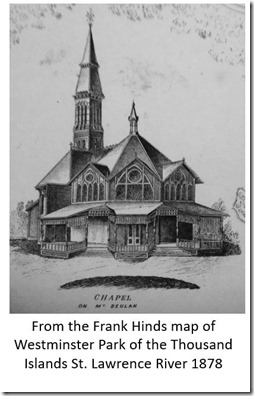
The Westminster Park Association was incorporated, and a pamphlet drawn outlining the plans for the community. This document, which was offered free of charge, described the intent for the community, its proposed location, the beauty of the land, the financial plans for raising capital, easy transportation from cities in New York State to the site, and proposals for the design of a Boarding Hall and a Chapel. The By-Laws provided a vision for the use of the proposed Chapel:
“Article 21: The chapel is intended for religious or other meetings. Parties desiring to occupy it will not be permitted to do so without the authority in writing of the president, or in his absence the vice-presidents, and in their absence of the majority of the Executive Committee, who shall first ascertain the character of the intended meeting - refusing the use thereof to all such as are not compatible with the objects and purposes of the Association.” 3
To generate enthusiasm for the development and construction of Westminster Park, a broad base of customers and investors was needed. In 1877 and 1878 many free or low-cost excursions were offered to citizens from upstate New York cities to travel by train and steamship to visit the proposed site of the project. (Often we see the founders of the park were principals in railway and steamship enterprises.)
One such excursion was reported in the Watertown ReUnion: “Approximately 175 people assembled for a free dinner in the dining hall of Thousand Islands Park, followed by a ride on the TS FAXTON steamship.”(Faxton’s niece Mary Powell of Utica purchased Lot 71 in the initial auction of cottage lots). “The destination was the proposed property for the Westminster Park community.” Time was provided to inspect the property and to hike the land. The group was then ferried back to Thousand Islands House in Alexandria Bay for supper. Later that evening, an organizational meeting was held announcing named officers and trustees of the Westminster Park Association and offering a history of the enterprise along with the financial reports. Shares of stock in the Association were offered for investors to purchase. 4
A number of such excursions, as well as enthusiastic reports in Upstate newspapers, and, quite possibly, praise for the project from a few Presbyterian pulpits across New York State, generated interest to invest. After raising sufficient capital, the trustees executed a contract to purchase the land and ordered a survey by civil engineer Frank A. Hinds of Watertown. (Frank Hinds was later the purchaser of Lots 103 and 138.) The plan of roads, lots, and community buildings began to become a reality.
Hinds drew up a map laying out the positions of the proposed buildings, roadways, docks, and lots slated to be sold to individuals. In the borders he sketched ideas for various proposed structures.
Among the first constructed were a storehouse and a “considerable dock”, a dining hall, and a “chapel for religious worship”.
The conscientious trustees and investors adopted the tenet to “pay as you go” and were not disposed to run in debt. 5. Hopes were high, as one minister “expressed the belief that the St. Lawrence would eventually become the most popular summer resort on the continent.”
From Thousand Island Park, the official newspaper of the Thousand Islands Camp Meeting Association commented, “We rejoice to learn that it is proposed to develop the Westminster Park at the lower end of the Island on which the Thousand Island Park is situated…. Between the two, there ought to be instructive and religious meeting of some kind held on the Island all summer.” 6
And so a community began to take shape:
On January 25, 1878, the Watertown Times reported on a Board of Trustees Meeting held at the Woodruff House in Watertown. “Plans and specifications for the chapel are to be received at once with a view of an early construction of that building.” By mid-March 1878 “a drawing of the chapel to be erected at the Park, the plans and specifications of which are from W. H. Hamilton, architect of Utica” was presented to the Trustees. It was announced that these plans and specifications for the chapel would be available for viewing at the office of Trustee Dr. J. D. Huntington of Watertown. Builders submitted sealed proposals, for the construction of the building, to be opened at the meeting of the building committee on the 20th of that month.
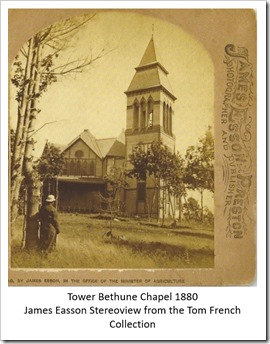 “This chapel is to be erected upon the top of the mound-shaped hill, called Mount Beulah, directly opposite Alexandria Bay, the elevation of which is about one hundred feet above the waters of the St. Lawrence, and will be plainly visible from many miles up and down the river. The elevation of the chapel tower is 186 feet.”7 (Incidentally, Architect William H. Hamilton was the future purchaser of lot 557 and Trustee Dr. Huntington lots 117 and 119.)
“This chapel is to be erected upon the top of the mound-shaped hill, called Mount Beulah, directly opposite Alexandria Bay, the elevation of which is about one hundred feet above the waters of the St. Lawrence, and will be plainly visible from many miles up and down the river. The elevation of the chapel tower is 186 feet.”7 (Incidentally, Architect William H. Hamilton was the future purchaser of lot 557 and Trustee Dr. Huntington lots 117 and 119.)
The Watertown ReUnion; March, 21, 1878, reports on the design: “…at the rear corner will be a square tower… first floor of the tower will be a study for the pastor which will be entered by an very handsome rural porch. On the side of the study will be steps leading to the belfry. …In place of stained glass the windows of the whole chapel and tower are to be covered with tinted cloth, which will be cool and furnish a softened light besides being economical.”
Newspaper reporters from all over Upstate New York published weekly reports to generate enthusiasm for the Westminster community at every stage of construction.
From the Watertown ReUnion; May 09, 1878,: “The chapel now in course of construction will be one of the most noticeable structures upon the magnificent river.”
Also from the report in the Watertown ReUnion; May 09, 1878: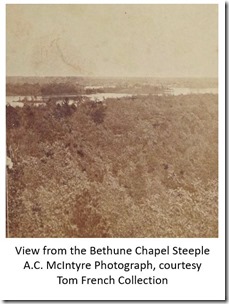
“The auditorium is hexagon in form and the transept is octagon, the seats being arranged in amphitheater style so that each commands a view of the pulpit. The chapel has five sides, which can be raised like a sash, allowing the occupant of the auditorium to have access to the broad piazza which surrounds it. The main auditorium is fifty feet in height, and will seat 366 persons, while the piazza will accommodate 600 additional. The chancel has an elevation of three feet; it will be eight feet broad and twenty-five feet in length. At the rear corner will be a square tower 136 feet in height. The chapel is to stand upon Mount Beulah. The lookout from the tower will be at least 225 feet above the river. With a good glass, the chapel can be seen from Cape Vincent or Ogdensburg on a clear day, and from points on the American and Canada side for many miles around.”
“The chapel will be reached by a gradual and easy ascent from the dock. It will be built of wood, with open rafters in the roof. All portions are to be handsomely and artistically painted and finished. The cornices and other ornaments of the tower are to be richly gilded, so that they will glisten in the sunshine. The outside dimensions of the building are eighty by one hundred and thirty feet. It will be ready for use during the coming summer.”
The Watertown ReUnion; May 09, 1878 continues:
“After our return, a trustee meeting was held which was quite prolific of results. It was decided to call the chapel ‘Bethune Chapel’ and the boarding hall ‘Park Hotel.’ President Fowler stated that President Sloan (a NY railroad magnate) had agreed to furnish transportation for a car-load of New York clergymen on the dedication day which will be the second Tuesday in July. His generous offer will be accepted and arrangements will be consummated to that very end. Westminster Park’s Vice President Lawrence gave a very interesting review of his travels abroad and in this country, and “concluded with the statement that in his judgment, the St. John’s River, Fla. was America’s desirable winter resort, and the St. Lawrence for summer. “
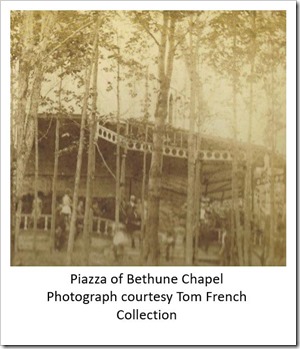 The name “Bethune Chapel” was adopted to honor Rev. George Washington Bethune (1805-1862), a clergyman of the Reformed Dutch Church, philanthropist, and an avid fisherman. On a trip to Alexandria Bay in 1840 he contributed to the founding of a Dutch Reformed Church in Alexandria Bay. His remarkable career as a clergyman, hymn writer, world traveler, fisherman, and his impeccable reputation earned him great respect in the Protestant world of the 1800’s. The New York Evening Post called him the “Modern Discoverer of the Thousand Isles of the Saint Lawrence” due to his published rambles on health and fishing. 8
The name “Bethune Chapel” was adopted to honor Rev. George Washington Bethune (1805-1862), a clergyman of the Reformed Dutch Church, philanthropist, and an avid fisherman. On a trip to Alexandria Bay in 1840 he contributed to the founding of a Dutch Reformed Church in Alexandria Bay. His remarkable career as a clergyman, hymn writer, world traveler, fisherman, and his impeccable reputation earned him great respect in the Protestant world of the 1800’s. The New York Evening Post called him the “Modern Discoverer of the Thousand Isles of the Saint Lawrence” due to his published rambles on health and fishing. 8
Construction continues
An update in the July press accounts explains the mechanism of the curtains designed to open the sanctuary to the piazza:
“Their chapel is a curious structure: within its walls proper 300 persons can be seated, but in case of a crowd by ingenious arrangement of its weights and jacks, the enclosure can be raised and 900 persons on the surrounding piazza can be encompassed within its curtains.” 9
The Bethune Chapel was to be the centerpiece of the community. No expense was to be spared in constructing this Gothic church. It was reported to have cost $3500, but “will have the appearance of a structure that could easily be made to cost $100,000 in any city.” 10. So extravagant!
One of the very amusing benefits of reading historic newspapers is that reporters offer personal opinions. I hope the following comment will not offend our Wellesley Island neighbors! A correspondent from the “Utica Morning Herald” wrote: “ The good name of the Presbyterians of New York State is connected with Westminster Park, and they can not afford to be connected with a failure. They are wealthier as a class than the Methodists, and have finer churches in the cities. They never make as much noise as the Methodists and there is not occasion for it, but to succeed in this experiment they must take hold of the work with a will, and make Westminster Park a success of which each one who invests his money will be proud and to which new faces will be attracted each year. Then when the shouts of ‘Glory Hallelujah’ are heard from the Methodists on the upper end of Wells Island, the Presbyterians on the lower end …can respond with a cheerful ‘amen’ that will be taken up and echoed back from the Palisades, Muskelunge Bay, the Canada shore, Deshler’s, Hayden’s, Manhattan, Summerland, and Sport Island, back from Bonnie Castle and Alexandria Bay, along up by Wau-we-net, Pullman’s, Nobby, Warner’s, Point Vivian, Grinnell’s Point, the Jolly Brothers, Fisher’s Landing, Round Island, and the Hub to the cottages and tents which cover the Thousand Island Park in every direction. I did not intend to write so much about the Methodists just now, but I would like to see the Presbyterians of Utica, Syracuse and the state generally emulate the example of their brethren and make Westminster Park into a summer home that will vie with any other similar place of resort on the river.” 11
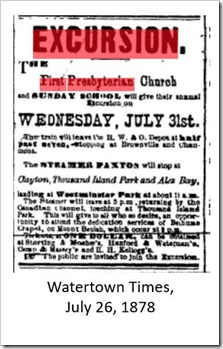 It is interesting to note that TIP’s worship buildings were nowhere near as grandiose as the Bethune Chapel. The earliest Methodist worship structure was an enormous tent. Other simple structures followed with a facade, a roof, and open sides. For the history of the chapels at TIP, one might like to read “Grindstone, Grenell, and Wellesley’s Historic Churches”, by Rick Tague which was published online at www.thousandislandlife.com, January 13, 2014. More information on Thousand Islands Tabernacle can be found in Tom French’s River Views; History of Thousand Islands in 3-D.
It is interesting to note that TIP’s worship buildings were nowhere near as grandiose as the Bethune Chapel. The earliest Methodist worship structure was an enormous tent. Other simple structures followed with a facade, a roof, and open sides. For the history of the chapels at TIP, one might like to read “Grindstone, Grenell, and Wellesley’s Historic Churches”, by Rick Tague which was published online at www.thousandislandlife.com, January 13, 2014. More information on Thousand Islands Tabernacle can be found in Tom French’s River Views; History of Thousand Islands in 3-D.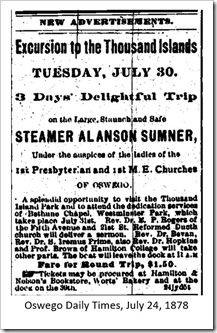
WP Construction reports continue: Watertown ReUnion; May 16, 1878: “The foundation for the chapel is nearly completed. Mr. F. K. Kessing of Ilion, has the contract to build the chapel, which will be ready for use about July 1st.”
“The Chapel at Westminster Park is well under way, the frame being up and enclosed. A high tower is to be erected upon it from which a splendid view of the scenery can be obtained.” 12
The Bethune Chapel was completed on time and preparations began for a grand dedication service to be held on July 31, 1878 at 2PM. Once again, this network of newspapers touted the affair. The transportation moguls planned convenient routes. Enthusiasm was the order of the day.
Advertisements were published in the Watertown Times, July 26, 1878. For a one dollar ticket, the public could enjoy a boat ride around Wellesley Island and arrive in time to attend the dedication service of the Bethune Chapel on Mount Beulah at 2PM.
Some extended excursions were offered by church groups from Upstate cities on various railroads with connections to River steamers. It should be remembered that many of the principals of Westminster Park had significant investments in the rail lines and steamboats. 13
Newspaper accounts reported crowds of “more than 4000 people were on the grounds” for the dedication of the Bethune Chapel. 14 (Note: Augustus C. Kessinger was the editor of the Rome Daily Sentinel and the owner of Lot 761.)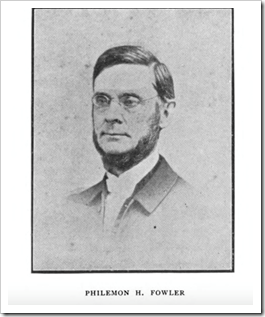
July 31, 1878! Dedication Day arrives!
The service was opened by Rev. Dr. Philemon H. Fowler, of Utica, a driving force of the Westminster Park project and the first President of the Westminster Park Association. Fowler, the retired minister of the Utica First Presbyterian Church/Olivet Chapel was a trustee of Hamilton College and a trustee of Auburn Theological Seminary. His influence brought many Uticans and Central New Yorkers to the Park. (Rev. Dr. Fowler had purchased Lot 629 in the May lot sale.)
The most distinguished religious clerics of the day were on hand. The dedicatory sermon was delivered by Rev. Ebenezer Platt Rogers of New York, Pastor of the 5th Avenue Reformed Church of New York and a leading divine in the Dutch Church. Rev. Samuel Iraneus Prime, of the New York “Observer” and Samuel Gilman Brown, President of Hamilton College, participated in the service. Other speakers included Rev. Drs. William Adams and L.D. Bevan of New York, and Dr. Hopkins of Auburn. From all accounts, it was a glorious affair. “Everything passed off smoothly, and the managers were jubilant at their success.” 14
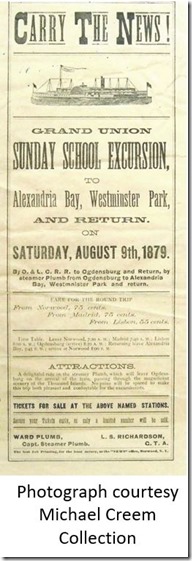 As the summer of 1878 continued, frequent events were held at the Bethune Chapel. Area newspapers report weekly services. Excursions from up and down the river continued in these early years as seen in this 1879 handbill at the left from one such group.
As the summer of 1878 continued, frequent events were held at the Bethune Chapel. Area newspapers report weekly services. Excursions from up and down the river continued in these early years as seen in this 1879 handbill at the left from one such group.
By the Summer of 1879, Westminster Park Association was publishing its own newspaper on a regular basis. From this document we see evidence that the religious enterprise received the endorsement of the Presbytery of St. Lawrence (within whose boundaries it is situated), the Presbytery of Utica and the Synod of Central New York. The Westminster Park Sabbath School Assembly was established under the leadership of Rev. Herrick Johnson, D. D. of Auburn Theological Seminary. (It might also be noted that Rev. Johnson served as President of the Westminster Park Association at this time. The former president, Philemon H. Fowler, died near the end of 1879, so it might be presumed age or health had caused him to leave the leadership to a younger man. Perhaps they had an alliance from Auburn Theological Seminary.)
The July 22, 1879 issue (Volume 1, Issue III) of the Westminster Park newspaper reports: The Sabbath School Assembly will run from July 27th to Aug. 3rd with daily sessions from 9 AM to 9 PM, covering subjects pertinent to the growth of the faith. Topics will range from Bible Studies to child rearing to music in worship, etc. Sessions will be conducted by speakers who had earned renown teaching in Chautauqua and in Philadelphia. Afternoons are free for excursions around the 1000 Islands. The ever-present suggestion of railroad transportation on the Rome, Watertown, and Ogdensburg line and the Utica & Black River Railroad were promised with the “fare the same as to the Thousand Island Camp Ground.” (Do we presume competition with TIP?) In 1879 the rails ended at Clayton or Morristown. The last leg of the journey from CNY cities was to made aboard the steamships of the river or stage coach from the rail terminus to the shore and then by boat.
The Association fulfilled its mission to offer “religious privileges… to include preaching as often in the week as those who become purchasers of lots may desire.” One such report read:
“Dr. Porter is expected to preach in the chapel at Westminster Park tomorrow. He will probably have a large audience. Improvements to some extent are being made on Westminster Park. There will be preaching there every Sunday during the remainder of the season.” 15
Unfortunate!
“Improvements”? This word is the first hint that something was awry. A magnificent house of worship holding dominance over the River landscape…the finest clerics of the time offering the teachings of the faith…a community of like-minded individuals who were flocking to these shores…. what would need improving?
Well, we need to back up to the planning stage of the project. Westminster Park Trustees initial suggestion had been to position the chapel in “a depressed portion of the park, but Architect Hamilton’s suggestion as to the great beauty of the elevated point were fortunately adopted.” from the Utica Herald, but reprinted in the Watertown ReUnion; March 21, 1878. Hindsight proved it was unfortunate!
It is difficult to imagine that this grandiose structure would be abandoned in just a few years. As early as 1880, the trustees discussed building a chapel nearer the hotel. 16
By the Spring of 1881, it is reported:
“Among the notable improvements to be made by the association, this season will be the erection of a new chapel to take the place of Bethune chapel on Mt Beulah. The present chapel stands on a site that has its elevation of 100 feet about the level of the river. The top of its tower is 225 feet above the water. If the intention of the founders of this chapel was to pierce the clouds as far as possible, and erect a prominent structure upon the river, their efforts were undoubtedly crowned with success. But the experience of the past has taught the new management” (now the Harrington Brothers) “that people do not care to climb one hundred feet to attend service on an extremely hot day and that the chapel is entirely unsuited for the purpose of public services, the acoustic properties being exceedingly poor. The new chapel will be erected just east of the hotel and upon the same level fronting the main river and Alexandria Bay. Its dimensions will be
36 X 52 feet and it will cost $3000.” (PLEASE NOTE THE 1881 DATE.) 17
One final attempt to salvage the investment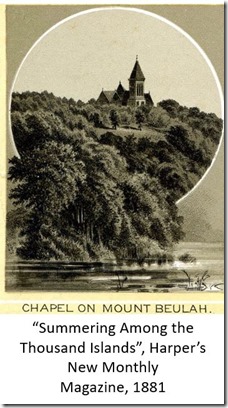
“The trustees of WP have decided to remodel the chapel on Mount Beulah, making many decided improvements in the structure and acoustic properties. The association will provide religious services every Sabbath, and perhaps oftener. The work of repairing the chapel will be under the management of Dr. J. C. Gallup of Hamilton College.” 18 (Gallup at that time was the Vice President of the Westminster Park Association and the owner of Lots 614-620.)
While complaints persisted, the Chapel continued to be used. “Repairs and alterations upon Bethune Chapel are so far completed that service will be held there next Sabbath, and a clergyman from New York is expected to officiate.” 19
Even though we see reported discussions of the desire to replace the chapel on Mount Beulah, more than a decade would pass before action was taken. It seems that the Bethune Chapel continued to be used for church services, as well as for musical events. e. g. “Rev. C. T. Goss (the husband of Gallup’s niece) of Utica will preach in the chapel at Westminster Park on Sunday next.” 20 Complainers were relentless. In “The Phat Boys 18 Years on the St. Lawrence River, the people met and the things seen” by Etta F. Babbage, daughter of Edward F. Babbage there is a comment, “There is a high hill on the island called Mount Beulah, though after climbing it, I think the Hill Difficulty would be a more appropriate name.”
We have read reports that the Bethune Chapel steeple was blown down in 1885. Weather records from that year note that New England and the Saint Lawrence Valley suffered torrential storms in July and August. To date, I have not found a record of damage to the spire, but it is possible.
In time this grandiose chapel built with such celebration and fanfare was cast aside for a newer, simpler structure on the Hotel grounds. What became of the Bethune Chapel on Mount Beulah is one of those mysteries yet to be uncovered. I am sure the information is out there waiting to be discovered by a History Detective.
|
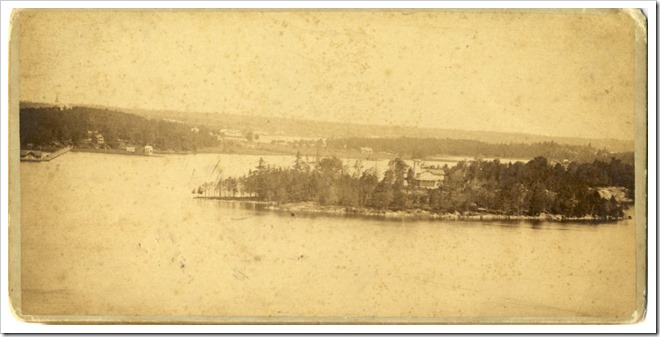
Notice this early A. C. McIntyre stereo-view. On the far left side of this early image we see the steeple of the Bethune Chapel rising above the second-growth forest of the Park. The long dock and storehouse can be seen at the water’s edge. Hotel structures are evident in the back-center section behind Hart Island.
Photo courtesy Tom French Collection
|
With appreciation to Tom French of Thousand Islands Park for sharing stereo view images and technical advice. His work can be seen at riverviews3d.com. Information on his book, River Views, is listed below. Thanks to Michael Creem who was always generous in sharing history with me.
Footnotes
1 Watertown Times; 11-19-1875
2 The Cornell Library New York State Historical Literature: The Westminster Park Association of the Thousand Islands.
3 Watertown ReUnion; 5-10-1877
4 Watertown ReUnion; May 3, 1877
5 Watertown ReUnion; May 3,1877
6 Watertown ReUnion; May 3, 1877
7 Watertown ReUnion; March 14, 1878.
8 NY Evening Post; 8-10-1878 0749.pdf
9 Watertown Times; 7-16-1878
10 Watertown ReUnion; March 21,1878
|
11 Utica Morning Herald; May 16, 1881
12 Watertown ReUnion; June 27, 1878
13 Oswego Daily Times, 7-24-1878
14 Rome Daily Sentinel; 8-06-1878, 01115.pdf fultonhistory.com
15 Mexico Independent no date given. www. fultonhistory.com.
16 Watertown Times; July 12, 1879
16 Watertown Re-Union; Dec. 30, 1880
17 Watertown Times; May 17, 1881
18 Watertown Times; August 03, 1881
19 Watertown Daily Times; 7-21-1882, .0068pdf www.FultonHistory.com
20 Watertown Daily Times; 08-18-1882.
|
Sources
nnyhistoricnewspapers.com and www.fultonhistory.com
Mexico Independent
New York Evening Post
Oswego Daily Times
Rome Daily Sentinel
Utica Morning Herald
Watertown ReUnion
Watertown Times
Babbage, E. F.; The Phat Boys; 15 years on the St. Lawrence: The People Met and the Things Seen: A Guide for Tourists and Travelers; Rochester and Chronicle Democrat, Rochester, New York, 1888
French, Tom, River Views; a History of the Thousand Islands in 3-D, Stone Island Press, Potsdam, New York, 2011
Harper’s New Monthly Magazine, “ Summering Among the Thousand Islands”, 1881
The Michael Creem Collection
Tague, Rick, “Grindstone, Grenell, and Wellesley’s Historic Churches”; January 13, 2014; thousandislandslife.com
“The Westminster Park of the Thousand Islands”, published by the Westminster Park Association, Volume 1, Number III; Alexandria Bay, July 22, 1879
“Westminster Park Association of the Thousand Islands”; Truair, Smith & Bruce, Printers and Bookbinders, 1878
By Linda Twichell
©Linda Twichell 2018
Linda Lewis Twichell, a fifty-five year resident of Westminster Park, has collected stories of the Westminster community since the 1970’s. In 2016 Linda and friend Leigh Charron presented “Westminster Park; A Tapestry of Tales”, a multi-media presentation shown at the Cornwall Brothers Museum, Alex Bay and at the Jefferson County Genealogy Society, Watertown. “Westminster Park’s Great Race of 1882” was written by Linda and published in the April 2017 thousandislandslife.com. A book of Westminster Park, its people, and their stories is in the works.









